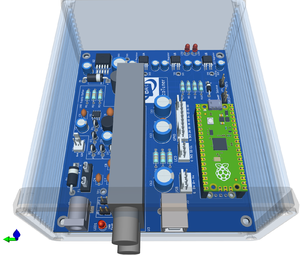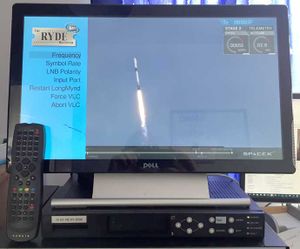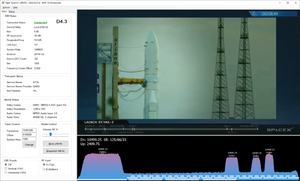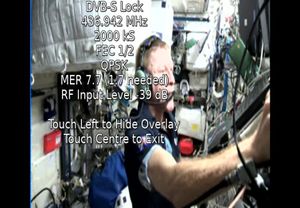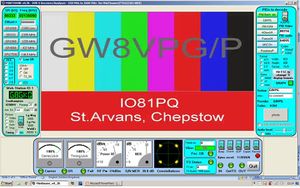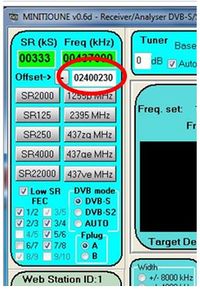Difference between revisions of "Receiving Oscar 100 DATV signals"
| (86 intermediate revisions by 2 users not shown) | |||
| Line 1: | Line 1: | ||
| − | Oscar 100 has an | + | Oscar 100 has an 9 MHz wide band transponder dedicated to Digital Amateur Television. |
The transponder spectrum can be monitored using the online spectrum monitor: https://eshail.batc.org.uk/wb/ However, to receive and decode the signals you will need to set up your own receiving station | The transponder spectrum can be monitored using the online spectrum monitor: https://eshail.batc.org.uk/wb/ However, to receive and decode the signals you will need to set up your own receiving station | ||
| Line 5: | Line 5: | ||
==Setting up the receive station== | ==Setting up the receive station== | ||
| − | A typical DATV receive system will consist of the | + | A typical DATV receive system will consist of the following: |
===Dish=== | ===Dish=== | ||
| − | To receive the DATV signals you will need at least a 90cms dish and | + | To receive the DATV signals you will need at least a 90cms dish and preferably 1m or larger - see this guide as to how to align your dish on the Es'hail-2 satellite: https://wiki.batc.org.uk/Es%27hail-2_Basic_Information#Aligning_your_dish |
===LNB=== | ===LNB=== | ||
| − | Just like any consumer satellite system, you will need an LNB at the dish to convert the | + | Just like any consumer satellite system, you will need an LNB at the dish to convert the 10GHz Ku band signals down to L Band which can then be decoded by the satellite receiver. |
| + | |||
| + | Whilst any modern Ku band satellite LNB will receive the Oscar 100 signals, particularly the 2Ms beacon, it is recommended that you use a Phase Lock Loop LNB. This is because the frequency stability of a standard DRO unit will make it difficult to receive the Narrow Band transponder SSB signals and Reduced Bandwidth DATV (RB-TV) signals on the wide band transponder. | ||
The most common unit is the Octagon Optima PLL OTLSO LNB (Beware there are a number of other Octagon units available which are standard DRO LNBs – ensure you buy the OTLSO PLL unit). | The most common unit is the Octagon Optima PLL OTLSO LNB (Beware there are a number of other Octagon units available which are standard DRO LNBs – ensure you buy the OTLSO PLL unit). | ||
| Line 19: | Line 21: | ||
See this page for more details: [[Es'hail-2 LNBs and Antennaes|https://wiki.batc.org.uk/Es%27hail-2_LNBs_and_Antennaes]] | See this page for more details: [[Es'hail-2 LNBs and Antennaes|https://wiki.batc.org.uk/Es%27hail-2_LNBs_and_Antennaes]] | ||
| − | ===DATV receiver=== | + | Note - it is recommended that you do not do any modifications to lock your LNB to an external source for DATV reception as it is beleived that these modifications can make DATV reception worse as they increase the phase noise of the LNB. |
| + | |||
| + | ===LNB power=== | ||
| + | The DATV transponder is horizontally polarised - this means the DATV receiver will need to be capable of providing 18v DC to the LNB to select horizontal polarisation required for the wide band transponder. | ||
| + | |||
| + | All satellite receivers can do this - select LNB voltage in set up - and when using MiniTiouner this can be done by using a step up regulator from 12v (plenty on ebay) and feeding 18v in to F2 and put J3 and J4 links in to fed the selected LNB. https://wiki.batc.org.uk/images/6/6d/SERIF.pdf | ||
| + | |||
| + | Alternatively you can physically rotate the LNB through 90 degrees offset so the cables are coming out of the side and then just fed it with 12v. | ||
| + | |||
| + | ==What receiver to use== | ||
| + | |||
| + | The frequencies in use are not standard satellite frequencies and the bit rates we use for ATV are lower than commercial satellites, the choice is limited. | ||
| + | |||
| + | To receive the wide band horizontally polarised DATV transponder you will need a DATV receiver capable of receiving 741 MHz to 749MHz. | ||
| + | |||
| + | Unfortunately this is outside the normal fequency tuning range of a standard consumer digital TV Set Top Box (STB). Therefore you will either need an additional up converter to shift the IF frequency up to be in the tuning range of the STB at L-band between 950 – 2150MHz. A Global ADX-Plus, an original Astra frequency extender or an SUP2400 converter previously sold by BATC will work. | ||
| + | |||
| + | Alternatively you can modify your PLL LNB by changing the 25MHz reference crystal to 26MHz to produce an IF output above 950MHz. | ||
| + | |||
| + | ===Standard satellite receivers=== | ||
| + | |||
| + | Once you have an upconverter or modified LNB you will be able to use a Free to Air DVBS2 (HD) receiver to receive the DATV beacon signal on 10,491.5 MHz which is transmitted using DVB-S2 1500 kS. Note, it must be a satellite receiver, not a terrestrial Freeview box, and a Sky box or similar service branded satellite box will not work - it must be a Free to Air (FTA) satellite box. | ||
| + | |||
| + | However, you will NOT be able to use most (95%) of consumer STB's to receive the Reduced bandwidth (RB-TV) signals which are typically 333Ks on Oscar 100. | ||
| + | |||
| + | ===Receivers designed for DATV=== | ||
| + | |||
| + | For optimum performance, a receiver designed for receiving narrow band DATV signals should be used. The Amateur TV community has developed a number of receive solutions based around a USB connected tuner hardware. | ||
| + | |||
| + | This USB hardware connects to either a PC or Raspberry Pi 4 via a USB port - software on the PC or Pi4 sets the frequency and symbol rate of the USB receiver hardware and decodes and displays the received signal. | ||
| + | |||
| + | ===USB Receiver hardware=== | ||
| + | |||
| + | The BATC Minitiouner and PicoTuner are PCBs which host the Serit 4334 satellite tuner and a USB interface. This unit is designed to be built at home, requiring only intermediate skills and does not use surface mount components. | ||
| + | |||
| + | ====Mark 2 MiniTiouner PCB==== | ||
| + | |||
| + | [[File:Serit complete.jpg|300px]] | ||
| + | |||
| + | This is the USB hardware which has been available for 7 years and is now replaced by the PicoTuner - see below. | ||
| + | |||
| + | For full details of the USB tuner hardware, including parts list and construction details see this wiki page: [[MiniTiouner hardware Version 2]] | ||
| + | |||
| + | ====PicoTuner PCB==== | ||
| + | |||
| + | [[File:Picotuner Mk1.png|300px]] | ||
| + | |||
| + | The PicoTuner is an enhanced version of the Mk2 MiniTiouner PCB launched in Spring 2024. | ||
| + | |||
| + | It replaces the FTDI USB interface on the original PCB with a Rpi Pico module. The Pico is not only significantly cheaper (£5 vs £32) but enables 2 stations to be received at once when used on the QO100 satellite. | ||
| + | |||
| + | The PicoTuner was released in April 2024 and is the recommended solution for new builders. | ||
| + | |||
| + | For more details see this wiki page [[PicoTuner]] | ||
| + | |||
| + | ===Software for use with the USB receiver=== | ||
| + | |||
| + | The USB hardware described above connects to either a PC or Raspberry Pi 4 via a USB port - software on the PC or Pi4 controls the USB receiver hardware and decodes and displays the received signal. | ||
| + | |||
| + | When the original HamTV was on the air, due to a problem with the DVB tables in the transmission, the MiniTiouner software by F6DZP running on Windows had to be used. | ||
| + | |||
| + | However, during the last few years several developments have taken and so we now have a choice of software to use with the Mk2 Serit 4334 based USB tuner hardware. | ||
| + | Note OpenTuner, Ryde and Portsdown receivers DO NOT support the Mk1 MiniTiouner hardware. | ||
| + | |||
| + | Any desktop PC since approx. 2014, or any mid+ laptop since approx 2017 should be capable of running the required software. | ||
| + | |||
| + | ===Ryde=== | ||
| + | |||
| + | Raspberry Pi 4 based set-top box software with IR handset remote control designed specifically for receiving narrow band DATV signals. | ||
| + | |||
| + | [[File:Ryde_With_Menu_Small.jpg|300px]] | ||
| + | |||
| + | For more details see this wiki page:[[Ryde Receiver]] | ||
| + | |||
| + | ===OpenTuner=== | ||
| + | |||
| + | PC based software developed by Tom ZR6TG | ||
| + | |||
| + | [[File:OT1.png|300px]] | ||
| + | |||
| + | For more details see this wiki page: [[OpenTuner]] | ||
| + | |||
| + | ===Portsdown=== | ||
| + | |||
| + | The BATC designed DATV transceiver system based on a Rpi 4 has a receiver which has been tested and decodes the HAMTV signal | ||
| + | |||
| + | [[File:Pdown rxr.jpg|300px]] | ||
| + | |||
| + | |||
| + | For more details see this wiki page [[The_Portsdown_DATV_transceiver_system#Portsdown_DATV_receiver]] | ||
| − | + | ===MiniTiouner=== | |
| − | + | The MiniTiouner software is still available however the author F6DZP is no longer involved in the amateur radio community so is not providing support or enhancements and you can no longer register on the Viva DATV forum to download the software. | |
| − | |||
| − | |||
| − | + | [[File:20160507 Walbury GW8VPG.jpg|300px]] | |
| − | |||
| − | == | + | ===PC software receivers=== |
| − | Once you have the system set up and you have successfully received the DATV beacon on | + | There are a number of software receivers that can use an SDR such as the ADALM Pluto and Hack RF to receive the RF/IF, and then perform the DVB-S demodulation in software. Those reported to work are listed below. |
| + | |||
| + | * SDRangel [https://www.sdrangel.org/ https://www.sdrangel.org/] | ||
| + | * SatDump [https://www.satdump.org/ https://www.satdump.org/] | ||
| + | ** Demonstration from Author using 2016 IQ recording: [https://twitter.com/aang254/status/1771869215776985466 https://twitter.com/aang254/status/1771869215776985466] | ||
| + | |||
| + | Do note that any software-based receiver is likely to be less sensitive (1dB+) than a hardware receiver and will require a more powerful computer to run. For this reason the BATC recommends to use a hardware receiver. | ||
| + | |||
| + | ===SDRs=== | ||
| + | |||
| + | Standard SDR software and hardware do not as standard receive DATV signals however, there are 2 programs for the advanced user which may work at some symbol rates: | ||
| + | |||
| + | SDRAngel: https://github.com/f4exb/sdrangel | ||
| + | |||
| + | Lean SDR: https://github.com/pabr/leansdr/tree/work | ||
| + | |||
| + | ==Setting up your receiver== | ||
| + | |||
| + | You will find it a lot easier to tune to the DATV signals on Oscar-100 if you put your LNB offset in to your receiver rather than try to enter the IF frequency such as 741.5MHz directly. | ||
| + | |||
| + | Most LNBs have a 9750 MHz local oscillator - when 9750000 is put in to your receiver offset (on MiniTiouner it is the white box directly below the frequency box) you can then just enter the 10 GHz freq shown on the spectrum display directly into your receiver. | ||
| + | |||
| + | [[File:Capture.JPG|200px]] | ||
| + | |||
| + | ===Tuning to the signals=== | ||
| + | |||
| + | Once you have the system set up and you have successfully received the DATV beacon on 10491.5 MHz 1500 kSS DVB-S2 you will be ready to receive DATV signals. | ||
All signals should appear on the channels listed in the bandplan: https://wiki.batc.org.uk/Es%27hail-2_DATV_Bandplan | All signals should appear on the channels listed in the bandplan: https://wiki.batc.org.uk/Es%27hail-2_DATV_Bandplan | ||
| Line 41: | Line 155: | ||
When you see a signal appear on the spectrum monitor, check the chat and enter the frequency, symbol rate (SR) and DVB-S or DVB-S2 mode in to your receiver. Once you have received the signal make sure you let the station know you have received them! | When you see a signal appear on the spectrum monitor, check the chat and enter the frequency, symbol rate (SR) and DVB-S or DVB-S2 mode in to your receiver. Once you have received the signal make sure you let the station know you have received them! | ||
| + | |||
| + | If you have the correct symbol rate set for a signal, you may find the receiver AFC may pull your receiver on to the frequency. Therefore you may find you receive the beacon on 10491.5 MHz when your receiver is tuned to 10493MHz. | ||
| + | |||
| + | For more details on how to use MiniTioune see this page [[MiniTioune software|https://wiki.batc.org.uk/MiniTioune_software]] | ||
| + | |||
| + | ==QO100 Live Tune== | ||
| + | |||
| + | Rob M0DTS has developed a small application designed to run on a PC that grabs the fft data from the BATC Wideband Spectrum monitor page and allows the user to click on signals which automatically configures Minitioune to the required settings to receive the signal via udp control. See [[QO100 Live Tune]] for more details and download instructions. | ||
==Further information== | ==Further information== | ||
| Line 48: | Line 170: | ||
==Typical receive results== | ==Typical receive results== | ||
| − | === | + | ===QO-100 DATV beacon - 10491.5 MHz, DVB-S2 1.5 MS FEC 4/5 === |
| + | |||
| + | The following (empty transponder) results are typical with a POTY feed using a "rocket" LNB lens: | ||
{| class="wikitable" | {| class="wikitable" | ||
|- | |- | ||
| − | ! Dish size !! MER | + | ! Dish size !! Received MER |
|- | |- | ||
| − | | | + | | 2.4m || 12 dB |
|- | |- | ||
| − | | || | + | | 1.8m || 11.5 dB |
|- | |- | ||
| − | | || | + | | 1.2m || 10 dB |
|- | |- | ||
| − | | || | + | | 1m || 9 dB |
|- | |- | ||
| − | | || | + | | 80cm || 8 dB |
|- | |- | ||
| − | | || || || | + | | 70cm || 7 dB |
| + | |- | ||
| + | | 60cm || 6 dB | ||
|} | |} | ||
| − | + | Using an optimised LNB and horn, results could be up to 1 dB better as the POTY with lens is not perfect. | |
| − | |||
| − | |||
| − | |||
| − | |||
| − | |||
| − | |||
| − | |||
| − | |||
| − | |||
| − | |||
| − | |||
Latest revision as of 08:44, 30 April 2024
Oscar 100 has an 9 MHz wide band transponder dedicated to Digital Amateur Television.
The transponder spectrum can be monitored using the online spectrum monitor: https://eshail.batc.org.uk/wb/ However, to receive and decode the signals you will need to set up your own receiving station
Setting up the receive station
A typical DATV receive system will consist of the following:
Dish
To receive the DATV signals you will need at least a 90cms dish and preferably 1m or larger - see this guide as to how to align your dish on the Es'hail-2 satellite: https://wiki.batc.org.uk/Es%27hail-2_Basic_Information#Aligning_your_dish
LNB
Just like any consumer satellite system, you will need an LNB at the dish to convert the 10GHz Ku band signals down to L Band which can then be decoded by the satellite receiver.
Whilst any modern Ku band satellite LNB will receive the Oscar 100 signals, particularly the 2Ms beacon, it is recommended that you use a Phase Lock Loop LNB. This is because the frequency stability of a standard DRO unit will make it difficult to receive the Narrow Band transponder SSB signals and Reduced Bandwidth DATV (RB-TV) signals on the wide band transponder.
The most common unit is the Octagon Optima PLL OTLSO LNB (Beware there are a number of other Octagon units available which are standard DRO LNBs – ensure you buy the OTLSO PLL unit).
See this page for more details: https://wiki.batc.org.uk/Es%27hail-2_LNBs_and_Antennaes
Note - it is recommended that you do not do any modifications to lock your LNB to an external source for DATV reception as it is beleived that these modifications can make DATV reception worse as they increase the phase noise of the LNB.
LNB power
The DATV transponder is horizontally polarised - this means the DATV receiver will need to be capable of providing 18v DC to the LNB to select horizontal polarisation required for the wide band transponder.
All satellite receivers can do this - select LNB voltage in set up - and when using MiniTiouner this can be done by using a step up regulator from 12v (plenty on ebay) and feeding 18v in to F2 and put J3 and J4 links in to fed the selected LNB. https://wiki.batc.org.uk/images/6/6d/SERIF.pdf
Alternatively you can physically rotate the LNB through 90 degrees offset so the cables are coming out of the side and then just fed it with 12v.
What receiver to use
The frequencies in use are not standard satellite frequencies and the bit rates we use for ATV are lower than commercial satellites, the choice is limited.
To receive the wide band horizontally polarised DATV transponder you will need a DATV receiver capable of receiving 741 MHz to 749MHz.
Unfortunately this is outside the normal fequency tuning range of a standard consumer digital TV Set Top Box (STB). Therefore you will either need an additional up converter to shift the IF frequency up to be in the tuning range of the STB at L-band between 950 – 2150MHz. A Global ADX-Plus, an original Astra frequency extender or an SUP2400 converter previously sold by BATC will work.
Alternatively you can modify your PLL LNB by changing the 25MHz reference crystal to 26MHz to produce an IF output above 950MHz.
Standard satellite receivers
Once you have an upconverter or modified LNB you will be able to use a Free to Air DVBS2 (HD) receiver to receive the DATV beacon signal on 10,491.5 MHz which is transmitted using DVB-S2 1500 kS. Note, it must be a satellite receiver, not a terrestrial Freeview box, and a Sky box or similar service branded satellite box will not work - it must be a Free to Air (FTA) satellite box.
However, you will NOT be able to use most (95%) of consumer STB's to receive the Reduced bandwidth (RB-TV) signals which are typically 333Ks on Oscar 100.
Receivers designed for DATV
For optimum performance, a receiver designed for receiving narrow band DATV signals should be used. The Amateur TV community has developed a number of receive solutions based around a USB connected tuner hardware.
This USB hardware connects to either a PC or Raspberry Pi 4 via a USB port - software on the PC or Pi4 sets the frequency and symbol rate of the USB receiver hardware and decodes and displays the received signal.
USB Receiver hardware
The BATC Minitiouner and PicoTuner are PCBs which host the Serit 4334 satellite tuner and a USB interface. This unit is designed to be built at home, requiring only intermediate skills and does not use surface mount components.
Mark 2 MiniTiouner PCB
This is the USB hardware which has been available for 7 years and is now replaced by the PicoTuner - see below.
For full details of the USB tuner hardware, including parts list and construction details see this wiki page: MiniTiouner hardware Version 2
PicoTuner PCB
The PicoTuner is an enhanced version of the Mk2 MiniTiouner PCB launched in Spring 2024.
It replaces the FTDI USB interface on the original PCB with a Rpi Pico module. The Pico is not only significantly cheaper (£5 vs £32) but enables 2 stations to be received at once when used on the QO100 satellite.
The PicoTuner was released in April 2024 and is the recommended solution for new builders.
For more details see this wiki page PicoTuner
Software for use with the USB receiver
The USB hardware described above connects to either a PC or Raspberry Pi 4 via a USB port - software on the PC or Pi4 controls the USB receiver hardware and decodes and displays the received signal.
When the original HamTV was on the air, due to a problem with the DVB tables in the transmission, the MiniTiouner software by F6DZP running on Windows had to be used.
However, during the last few years several developments have taken and so we now have a choice of software to use with the Mk2 Serit 4334 based USB tuner hardware.
Note OpenTuner, Ryde and Portsdown receivers DO NOT support the Mk1 MiniTiouner hardware.
Any desktop PC since approx. 2014, or any mid+ laptop since approx 2017 should be capable of running the required software.
Ryde
Raspberry Pi 4 based set-top box software with IR handset remote control designed specifically for receiving narrow band DATV signals.
For more details see this wiki page:Ryde Receiver
OpenTuner
PC based software developed by Tom ZR6TG
For more details see this wiki page: OpenTuner
Portsdown
The BATC designed DATV transceiver system based on a Rpi 4 has a receiver which has been tested and decodes the HAMTV signal
For more details see this wiki page The_Portsdown_DATV_transceiver_system#Portsdown_DATV_receiver
MiniTiouner
The MiniTiouner software is still available however the author F6DZP is no longer involved in the amateur radio community so is not providing support or enhancements and you can no longer register on the Viva DATV forum to download the software.
PC software receivers
There are a number of software receivers that can use an SDR such as the ADALM Pluto and Hack RF to receive the RF/IF, and then perform the DVB-S demodulation in software. Those reported to work are listed below.
- SDRangel https://www.sdrangel.org/
- SatDump https://www.satdump.org/
- Demonstration from Author using 2016 IQ recording: https://twitter.com/aang254/status/1771869215776985466
Do note that any software-based receiver is likely to be less sensitive (1dB+) than a hardware receiver and will require a more powerful computer to run. For this reason the BATC recommends to use a hardware receiver.
SDRs
Standard SDR software and hardware do not as standard receive DATV signals however, there are 2 programs for the advanced user which may work at some symbol rates:
SDRAngel: https://github.com/f4exb/sdrangel
Lean SDR: https://github.com/pabr/leansdr/tree/work
Setting up your receiver
You will find it a lot easier to tune to the DATV signals on Oscar-100 if you put your LNB offset in to your receiver rather than try to enter the IF frequency such as 741.5MHz directly.
Most LNBs have a 9750 MHz local oscillator - when 9750000 is put in to your receiver offset (on MiniTiouner it is the white box directly below the frequency box) you can then just enter the 10 GHz freq shown on the spectrum display directly into your receiver.
Tuning to the signals
Once you have the system set up and you have successfully received the DATV beacon on 10491.5 MHz 1500 kSS DVB-S2 you will be ready to receive DATV signals.
All signals should appear on the channels listed in the bandplan: https://wiki.batc.org.uk/Es%27hail-2_DATV_Bandplan
Because you need to know a number of parameters before you can start to receive a signal, BATC has set up a dedicated chat line beside the spectrum monitor https://eshail.batc.org.uk/wb/
When you see a signal appear on the spectrum monitor, check the chat and enter the frequency, symbol rate (SR) and DVB-S or DVB-S2 mode in to your receiver. Once you have received the signal make sure you let the station know you have received them!
If you have the correct symbol rate set for a signal, you may find the receiver AFC may pull your receiver on to the frequency. Therefore you may find you receive the beacon on 10491.5 MHz when your receiver is tuned to 10493MHz.
For more details on how to use MiniTioune see this page https://wiki.batc.org.uk/MiniTioune_software
QO100 Live Tune
Rob M0DTS has developed a small application designed to run on a PC that grabs the fft data from the BATC Wideband Spectrum monitor page and allows the user to click on signals which automatically configures Minitioune to the required settings to receive the signal via udp control. See QO100 Live Tune for more details and download instructions.
Further information
There is a lot of information published on this wiki and also more discussion on the BATC forum here: https://forum.batc.org.uk/viewforum.php?f=101
Typical receive results
QO-100 DATV beacon - 10491.5 MHz, DVB-S2 1.5 MS FEC 4/5
The following (empty transponder) results are typical with a POTY feed using a "rocket" LNB lens:
| Dish size | Received MER |
|---|---|
| 2.4m | 12 dB |
| 1.8m | 11.5 dB |
| 1.2m | 10 dB |
| 1m | 9 dB |
| 80cm | 8 dB |
| 70cm | 7 dB |
| 60cm | 6 dB |
Using an optimised LNB and horn, results could be up to 1 dB better as the POTY with lens is not perfect.

